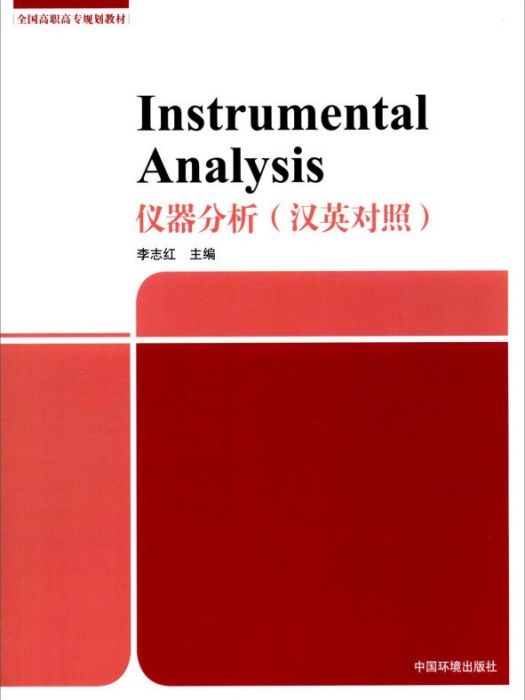《Instrumental Analysis (儀器分析)》是2016年中國環境出版社出版的圖書,作者是李志紅。
基本介紹
- 書名:Instrumental Analysis (儀器分析)
- 作者:李志紅
- 出版社:中國環境出版社
- ISBN:9787511128539
內容簡介,目錄,
內容簡介
《儀器分析(漢英對照)》共有7章,內容包含:電位分析法、紫外—可見分光光度法、原子吸收分光光度法、氣相色譜分析法、高效液相色譜分析法、紅外光譜法、質譜法。在編寫過程中充分汲取了國外同類教材的新內容,並結合國內現行教材的編寫特點,採用“中文導讀+難點譯註”的方式,中文與英文在內容表述上相輔相成,方便讀者全面地了解和掌握常見的儀器分析技術。在每章內容結束後還附有思考練習題,部分章節還給出了建議開設的實驗,以幫助學生和教師對相關學習內容進行檢查與鞏固。
目錄
中文導讀:1電位分析法
1.1 原理簡介
1.2 能斯特方程的套用
1.3 離子選擇電極
1.4 直接電位法
1.5 電位滴定法
1.6 電位滴定法的實驗數據處理
1.7 電位測定相對誤差評價
Chapter 1 Potentiometry
1.1 Introduction
1.2 Indicator Electrodes
1.3 Ion Selective Electrode (pH electrode)
1.3.1 Metallic Electrodes
1.3.2 Membrane Electrodes
1.3.3 Glass Membrane Electrodes
1.3.4 Crystalline Solid—State Electrodes
1.3.5 Liquid Membrane ISES
1.4 Analytical Applications of Potentiometry
1.4.1 Direct Measurement of an Ion Concentration
1.4.2 Potentiometric Titrations
1.4.3 pH Measurements
1.4.4 Errors in pH Measurement with Glass Electrodes
1.4.5 pH Titrations
1.4.6 Titrations of Weak Acids and Bases
1.5 Suggested Experiments
1.6 Problems
中文導讀:2紫外—可見分光光度法
2.1 相關知識
2.2 原理簡介
2.3 分光光度計
Chapter 2 Ultraviolet and visible absorption spectroscopy
2.1 Introduction
2.2 Electromagnetic Radiation
2.2.1 What is Electromagnetic Radiation
2.2.2 UV—vis Spectmm
2.3 Molecules and Molecular Spectroscopy
2.3.1 Rotational Transitions in Molecules
2.3.2 Vibrational Transitions in Molecules
2.3.3 Electronic Transitions in Molecules
2.4 Lambert—Beer's law
2.4.1 Absorbance and Transmittance
2.4.2 Lambert—Beer's law
2.4.3 Deviations from Beer's Law
2.5 Instrumentation in the UV/Visible
2.5.1 Radiation Source
2.5.2 Wavelength Selection Device
2.5.3 Sample Holder
2.5.4 Detector
2.5.5 Single—Beam and Double—Beam Instruments
2.6 Quantitative analysis by absorption measurements
2.6.1 Procedural Details
2.6.2 Methods in Quantitative Analysis
2.6.3 Analysis of Mixtures of Absorbing Substances
2.7 Accuracy&precision in UV/VIS absorption spectrometry
2.8 Suggested Experiments
2.9 Problems
中文導讀:3原子吸收分光光度法
3.1 基本原理
3.2 原子吸收分光光度儀主要部件功能簡介
Chapter 3 Atomic Absorption Spectroscopy
3.1 Introduction
3.2 Absorption of Radiant Energy by Atoms
3.2.1 Boltzmann Distribution
3.2.2 Measurements by Atomic Absorption
3.3 Instrumentation
3.3.1 Radiation Sollrces
3.3.2 Atomizers
3.3.3 Monochromator
3.3.4 Detectors
3.4 Correction of interfering absorptions
3.5 Analytical applications of AAS
3.5.1 Qualitative Analysis
3.5.2 Quantitative Analysis
3.6 Suggested Experiments
3.7 Problems
中文導讀:4氣相色譜分析法
4.1 色譜法簡介
4.2 基本原理
4.3 色譜法的分類
4.4 氣相色譜儀及色譜流出曲線圖
4.5 組分與固定相的作用
4.6 程式升溫技術
4.7 色譜分離基礎理論
4.8 衡量總體分離效果的指標——分離度R
Chapter 4 Gas chromatography
4.1 Introduction
4.2 Background in formation of chromatography
4.3 General concepts of analytical chromatography
4.4 The chromatogram
4.5 Retention parameters
4.5.1 Retention times
4.5.2 Retention volume (or elution volume) VR
4.5.3 Hold—up volume (or dead volume) VM
4.5.4 Retention (or capacity) factor k
4.6 Separation factor between two solutes
4.7 Resolution factor between two peaks
4.8 Techniques by physical state of mobile phase
4.8.1 Gas chromatography(GC)
4.8.2 Liquid chromatography (LC)
4.9 Essential theories of chromatography
4.9.1 The plate theory
4.9.2 The rate theory of chromatography
4.9.3 Golay's equation
4.10 Optimization of a chromatographic analysis
4.11 Gas chromatography
4.11.1 Components of a GC installation
4.11.2 Mobile Phase
4.11.3 Chromatographic Columns
4.11.4 Stationary Phases
4.11.5 Sample Introduction
4.11.6 Temperature Control
4.11.7 Detectors for Gas Chromatography
4.12 Quantitative Analysis
4.12.1 Analyses Based on Peak Height
4.12.2 Analyses Based on Peak Areas
4.12.3 Calibration and Standards
4.12.4 The Internal—Standard Method
4.12.5 The Area—Normalization Method
4.12.6 Quantitative Applications of GC
4.13 Qualitative Analysis
4.13.1 The Retention Index
4.13.2 Evaluation
4.13.3 GC Coupled with Spectroscopic Detection
4.14 Problems
中文導讀:5高效液相色譜分析法
5.1 高效液相色譜簡介
5.2 高效液相色譜法與氣相色譜法的比較
5.3 高效液相色譜主要類型
5.4 高效液相色譜儀
5.5 梯度洗脫技術
Chapter 5 High—performance liquid chromatography
5.1 Introduction
5.2 The beginnings of HPLC
5.3 General concept of an HPLC system
5.4 Pumps and gradient elution
5.4.1 Pumps
5.4.2 Low and high pressure gradients
5.7 Stationary Phases
5.9 Detectors for HPLC
5.10 Quantitative Applications
5.12 Evolution and applications of HPLC
5.13 Problems
……
中文導讀:6紅外光譜法
Chapter 6 Infrared Spectroscopy
中文導讀:7質譜法
Chapter 7 Mass Spectrometry

